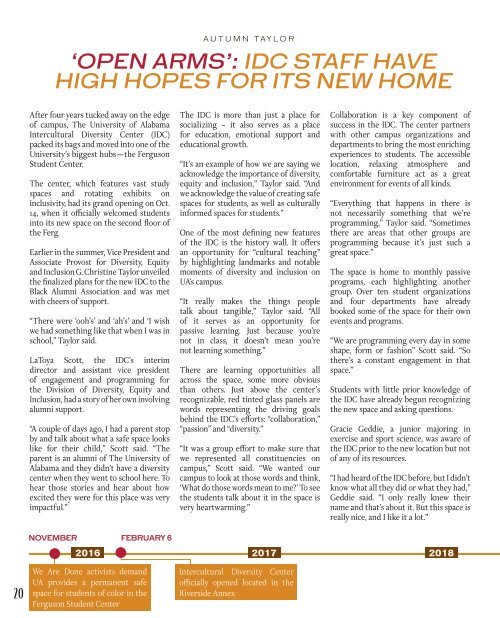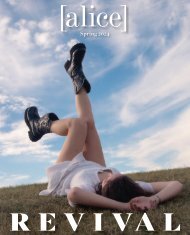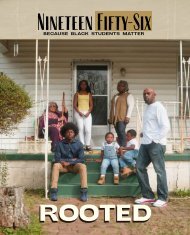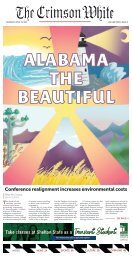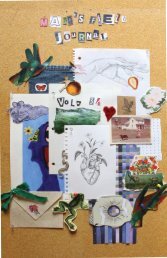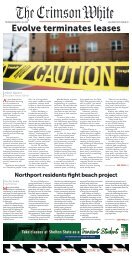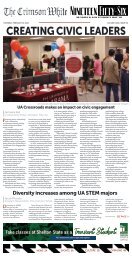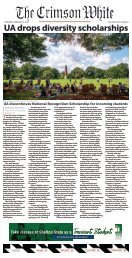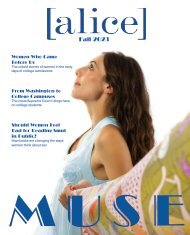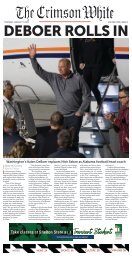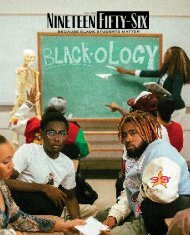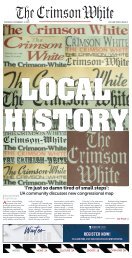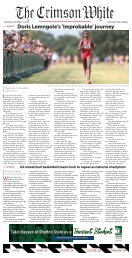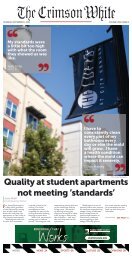CW + 1956 Collab Edition
In this first-ever collaborative issue between Nineteen-Fifty-Six and The Crimson White, we bring you stories of frustration and hope, change and stagnation, raging against the machine and working to change it from within. We hope you enjoy reading it as much as we enjoyed making it for you.
In this first-ever collaborative issue between Nineteen-Fifty-Six and The Crimson White, we bring you stories of frustration and hope, change and stagnation, raging against the machine and working to change it from within. We hope you enjoy reading it as much as we enjoyed making it for you.
You also want an ePaper? Increase the reach of your titles
YUMPU automatically turns print PDFs into web optimized ePapers that Google loves.
AUTUMN TAYLOR<br />
‘OPEN ARMS’: IDC STAFF HAVE<br />
HIGH HOPES FOR ITS NEW HOME<br />
After four years tucked away on the edge<br />
of campus, The University of Alabama<br />
Intercultural Diversity Center (IDC)<br />
packed its bags and moved into one of the<br />
University’s biggest hubs—the Ferguson<br />
Student Center.<br />
The center, which features vast study<br />
spaces and rotating exhibits on<br />
inclusivity, had its grand opening on Oct.<br />
14, when it officially welcomed students<br />
into its new space on the second floor of<br />
the Ferg.<br />
Earlier in the summer, Vice President and<br />
Associate Provost for Diversity, Equity<br />
and Inclusion G. Christine Taylor unveiled<br />
the finalized plans for the new IDC to the<br />
Black Alumni Association and was met<br />
with cheers of support.<br />
“There were ‘ooh’s’ and ‘ah’s’ and ‘I wish<br />
we had something like that when I was in<br />
school,” Taylor said.<br />
LaToya Scott, the IDC’s interim<br />
director and assistant vice president<br />
of engagement and programming for<br />
the Division of Diversity, Equity and<br />
Inclusion, had a story of her own involving<br />
alumni support.<br />
“A couple of days ago, I had a parent stop<br />
by and talk about what a safe space looks<br />
like for their child,” Scott said. “The<br />
parent is an alumni of The University of<br />
Alabama and they didn’t have a diversity<br />
center when they went to school here. To<br />
hear those stories and hear about how<br />
excited they were for this place was very<br />
impactful.”<br />
The IDC is more than just a place for<br />
socializing – it also serves as a place<br />
for education, emotional support and<br />
educational growth.<br />
“It’s an example of how we are saying we<br />
acknowledge the importance of diversity,<br />
equity and inclusion,” Taylor said. “And<br />
we acknowledge the value of creating safe<br />
spaces for students, as well as culturally<br />
informed spaces for students.”<br />
One of the most defining new features<br />
of the IDC is the history wall. It offers<br />
an opportunity for “cultural teaching”<br />
by highlighting landmarks and notable<br />
moments of diversity and inclusion on<br />
UA’s campus.<br />
“It really makes the things people<br />
talk about tangible,” Taylor said. “All<br />
of it serves as an opportunity for<br />
passive learning. Just because you’re<br />
not in class, it doesn’t mean you’re<br />
not learning something.”<br />
There are learning opportunities all<br />
across the space, some more obvious<br />
than others. Just above the center’s<br />
recognizable, red tinted glass panels are<br />
words representing the driving goals<br />
behind the IDC’s efforts: “collaboration,”<br />
“passion” and “diversity.”<br />
“It was a group effort to make sure that<br />
we represented all constituencies on<br />
campus,” Scott said. “We wanted our<br />
campus to look at those words and think,<br />
‘What do those words mean to me?’ To see<br />
the students talk about it in the space is<br />
very heartwarming.”<br />
<strong>Collab</strong>oration is a key component of<br />
success in the IDC. The center partners<br />
with other campus organizations and<br />
departments to bring the most enriching<br />
experiences to students. The accessible<br />
location, relaxing atmosphere and<br />
comfortable furniture act as a great<br />
environment for events of all kinds.<br />
“Everything that happens in there is<br />
not necessarily something that we’re<br />
programming,” Taylor said. “Sometimes<br />
there are areas that other groups are<br />
programming because it’s just such a<br />
great space.”<br />
The space is home to monthly passive<br />
programs, each highlighting another<br />
group. Over ten student organizations<br />
and four departments have already<br />
booked some of the space for their own<br />
events and programs.<br />
“We are programming every day in some<br />
shape, form or fashion” Scott said. “So<br />
there’s a constant engagement in that<br />
space.”<br />
Students with little prior knowledge of<br />
the IDC have already begun recognizing<br />
the new space and asking questions.<br />
Gracie Geddie, a junior majoring in<br />
exercise and sport science, was aware of<br />
the IDC prior to the new location but not<br />
of any of its resources.<br />
“I had heard of the IDC before, but I didn’t<br />
know what all they did or what they had,”<br />
Geddie said. “I only really knew their<br />
name and that’s about it. But this space is<br />
really nice, and I like it a lot.”<br />
NOVEMBER<br />
FEBRUARY 6<br />
2016 2017<br />
2018<br />
20<br />
We Are Done activists demand<br />
UA provides a permanent safe<br />
space for students of color in the<br />
Ferguson Student Center<br />
Intercultural Diversity Center<br />
officially opened located in the<br />
Riverside Annex


